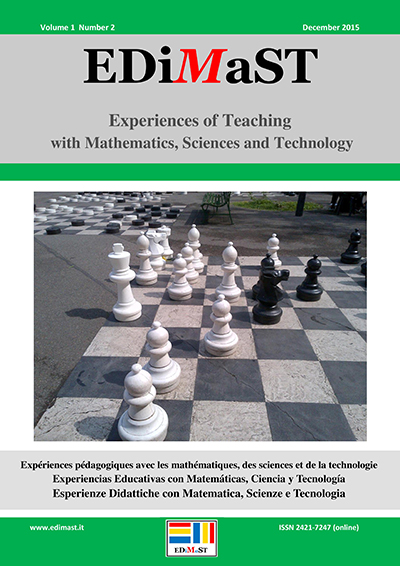Intuitive Geometry by Emma Castelnuovo: still contemporary in the digital devices’ era
Keywords:
Castelnuovo, DGS, GeoGebra, Intuitive geometryAbstract
Emma Castelnuovo has been one of the most influent innovators of the Italian mathematics Education. She published for the first time her book “Intuitive Geometry” in 1949, by which she presented a completely new perspective of geometry teaching/learning. Castelnuovo’s work had a strong impact on mathematics education. Nowadays, educational innovation is often confused with the use of digital devices; so it would seem that intuitive geometry by Castelnuovo, based on material models manipulation, is destined to have no more room in our classes. In this paper, we support the opposite conclusion: dynamic geometry softwares allow performing those explorations, which have always been promoted by Castelnuovo but with some differences. A classroom activity in grade 6 is used as example to support our conclusion.
References
Andrà, C., & Santi, G. (2011). A semiotic characterization of intuitions. In B. Ubuz (Ed.) Proceedings of the 35th Conference of the International Group for Psychology of Mathematics Education. Vol. 4, pp. 113-120. Ankara, TR.
Arzarello, F., Olivero, F., Paola, D., & Robutti, O. (2002). A cognitive analysis of dragging practices in Cabri environments. ZDM, 34(3), 66-72.
Bartolini Bussi, M.G., Taimina, D., & Isoda, M. (2010). Concrete models and dynamic instruments as early technology tools in classrooms at the dawn of ICMI: from Felix Klein to present applications in mathematics classrooms in different parts of the world. ZDM, 42(1), 19-31.
Castelnuovo, E. (1963). La didattica della matematica. Firenze: La Nuova Italia. Translations: Castelnuovo, E. (1968). Didaktik der Mathematik. Frankfurt am Mein: Akadem. Vlgs. Gesell. Castelnuovo, E. (1970). Didáctica de la Matemática moderna. Mexico: Trillas.
Castelnuovo, E. (1949-1964). Geometria intuitiva. Firenze: La Nuova Italia
Castelnuovo, E. (2008). In F. Lorenzoni (Ed.), L’officina matematica: ragionare con i materiali. Molfetta: La Meridiana.
Furinghetti, F., & Menghini, M. (2014). The role of concrete materials in Emma Castelnuovo’s view of mathematics teaching. Educational Studies in Mathematics, 87, pp.1-6.
Hollebrands, K., Laborde, C., & Sträßer, R. (2007). The learning of geometry with technology at the secondary level. In M. K. Heid & G. Blume (Eds.), Handbook of Research on Technology in the Learning and Teaching of Mathematics: Syntheses and Perspectives. Greenwich, CT: Information Age Publishing.
Sträßer, R. (2002). Research on dynamic geometry software (DGS) — an introduction. ZDM, 34(3), 65-65.
UMI-CIIM (2001). Matematica per il cittadino – Matematica 2001.





